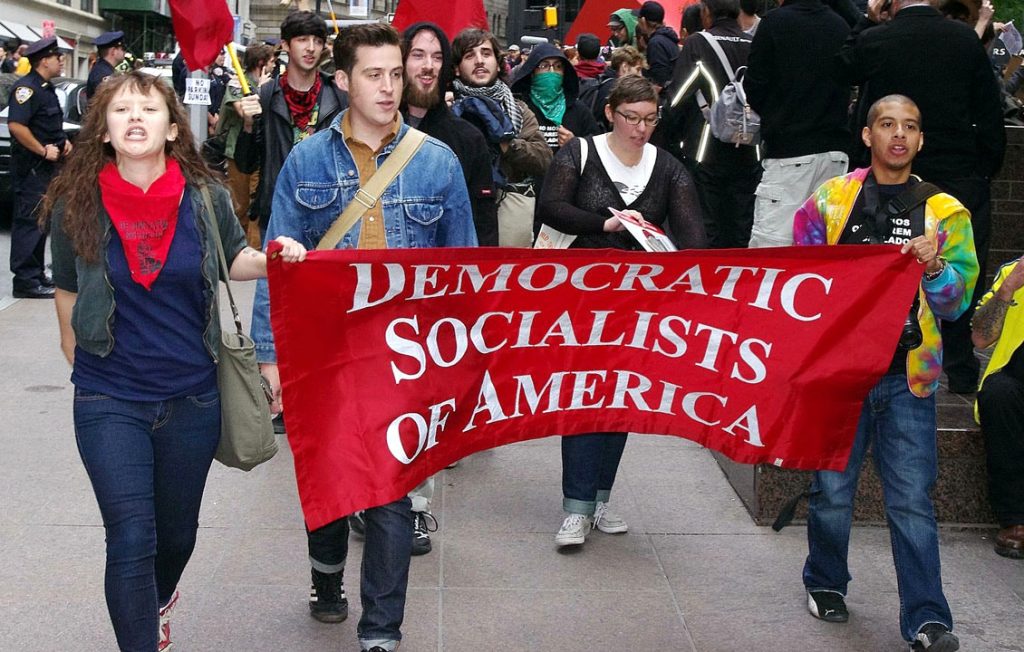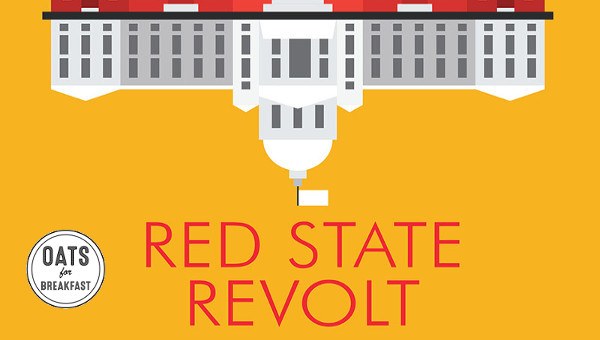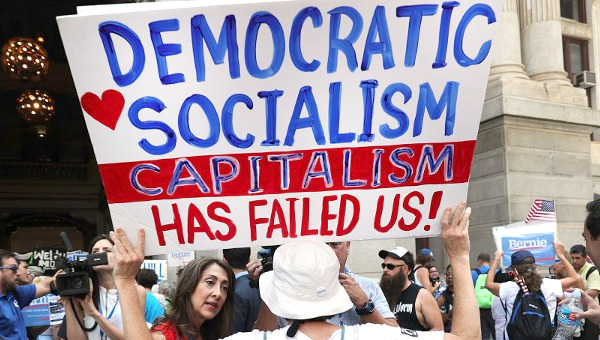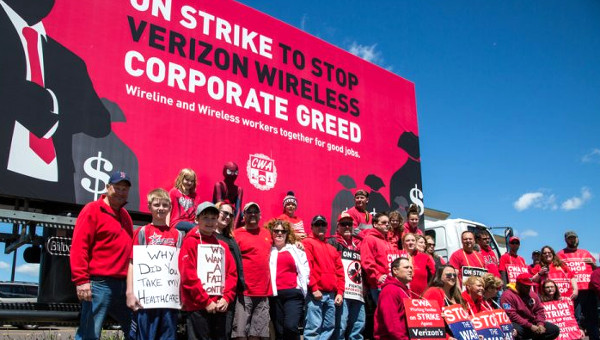A Labor Strategy for the US: DSA Debates
Early next month, over a thousand socialists will gather in Atlanta, Georgia to discuss the future of the Democratic Socialists of America (DSA). There is general agreement across many tendencies on the need to strengthen our labor work and that the Democratic Socialist Labor Commission (DSLC) is under-resourced and could sorely use at least one full-time staffer. It is a very positive development that so many DSA members now see labor organizing as central to the socialist project.
 All the main labor resolutions this year agree that we need more resources for the DSLC but not all agree on what DSA’s labor work should look like. Here’s our take on the strengths and limitations of Resolution 3 written by the comrades in Collective Power Network (CPN), one of several tendencies in DSA. In our view, Resolution 3 makes thoughtful organizational proposals and puts forward good general goals. But since CPN doesn’t call for workers to organize from the bottom up to transform the labor movement, and since it doesn’t articulate a strategy or a clear set of priorities, the convention should also endorse Resolution 32 and the rank-and-file strategy that it advocates. The two resolutions are complementary, not contradictory.
All the main labor resolutions this year agree that we need more resources for the DSLC but not all agree on what DSA’s labor work should look like. Here’s our take on the strengths and limitations of Resolution 3 written by the comrades in Collective Power Network (CPN), one of several tendencies in DSA. In our view, Resolution 3 makes thoughtful organizational proposals and puts forward good general goals. But since CPN doesn’t call for workers to organize from the bottom up to transform the labor movement, and since it doesn’t articulate a strategy or a clear set of priorities, the convention should also endorse Resolution 32 and the rank-and-file strategy that it advocates. The two resolutions are complementary, not contradictory.
CPN’s Labor Resolution
The Collective Power Network has put forward an ambitious and thoughtful raft of resolutions for the convention, focused on mass growth and organizational development. Its labor resolution states that DSA’s labor work requires “a clear strategy, with flexibility based on the diversity of regional labor conditions, along with a serious commitment from our members and their national bodies.”
CPN’s resolution proposes developing chapter-level labor groups whose representatives should lead a restructured DSLC. And like Resolution 32 drafted by members of Bread & Roses, it also proposes to hire a full time staffer for the DSLC and to strengthen our labor educational and training efforts.
What CPN’s resolution lacks, however, is the “clear strategy” that it calls for. The final “Resolved” reads:
Resolved, that the overall strategy of the DSLC shall be informed by strategic assessments of local conditions, and shall therefore be focused on developing local DSA labor networks that can pursue the following goals:
- Organizing within unions where they exist, especially when doing so provides opportunities to leverage demands against the state for the common good of the working class in general,
- Organizing within strategic industries, particularly where the potential economic impact on capital is greatest, and
- Leading efforts to organize workers in key unorganized sectors.
These are very broad goals – all of which are in line with the already existing mandate for the DSLC passed by the 2017 National DSA convention. But which of these goals are the most important to focus on in the current political period, given the state of the labor movement and the composition of DSA? Can DSAers help organize large numbers of unorganized workers without the resources and support of existing unions? And what should DSA members actually do within existing unions?
Bread & Roses members agree with CPN that it should be up to comrades and chapters on the ground to make decisions about what exactly to focus on locally. But what is the “clear strategy” and “clarity about priorities” that CPN thinks should inform these choices? This is not clarified by either Resolution 3, Annabel Vera’s article in defense of the CPN proposal, nor Ryan Mosgrove’s recent attack on the rank-and-file strategy.
Should We Transform Unions?
The point of the rank-and-file strategy – which aims to reconnect the Left and labor through developing a broad layer of militant, organic workplace leaders – is not to impose a one-size-fits-all approach on chapters across the country. For example, the openings for getting union jobs are obviously higher in a city like New York than in New Orleans, obliging different practical emphases by DSA chapters. But this doesn’t change the utility of having a clear strategic answer to the question of whether, all other things being equal, we should generally encourage DSAers to try to do political work within unionized or unorganized workplaces.
Similarly, any “clear strategy” should be able to clearly state whether DSA should generally support rank-and-file efforts to transform conservatized unions into democratic and militant organizations.
It’s great that the comrades in CPN call for “organizing within unions where they exist” and call to “defend and strengthen the already-existing labor movement.” We agree. But CPN’s proposed resolution and articles say nothing about whether or not DSA members should seek to transform our unions. CPN’s contributions note the decline in organized labor over recent decades, but are silent about the ways the failed political orientation of most unions has contributed to this decline.
Yet as labor strategists like Jane McAlevey and networks like Labor Notes have correctly pointed out, most unions are not currently succeeding in reversing the decline in union density because they are generally focused on shallow mobilization and lobbying Democratic Party politicians, rather than deep organizing, workplace militancy, and bottom-up democracy.
A “clear strategy” for DSA needs to be able to answer whether or not we should generally support organized rank-and-file challenges to take back our unions from the moderate, often ineffective leadership that continues to dominate the labor movement across the country.
For instance, which side should DSAers be on in the ongoing struggle between Teamsters for a Democratic Union and the old-school Hoffa leadership of the Teamsters that undemocratically rammed through a concessionary contract in late 2018 despite a majority of members voting it down?
The recent examples of rank-and-file teacher caucuses – from Los Angeles to Baltimore – winning back their unions in order to turn them into democratic and militant vehicles for deep organizing should be generalized across the country in most industries. While DSA should try to work with all unions to fight capitalists and organize new workers, rejecting the rank-and-file strategy risks moving DSA back toward its old failed orientation of subordinating our strategy to moderate labor leaderships and their reliance on the Democratic Party.
Given that CPN’s proposed resolution and related articles do not argue for politically transforming the unions, it is unsurprising that they also do not make any case for the best way to accomplish this task.
As Bread & Roses members have argued elsewhere, rank-and-file workers are in the best position to push for the dramatic political changes needed within organized labor – and to win over worker-leaders to socialist politics. In those relatively rare cases where there are staff positions open in militant unions like the United Teachers of Los Angeles that are focused on rank-and-file empowerment, it would make sense to connect DSAers to these jobs. Good, experienced staff can make a tremendous difference in organizing campaigns. But the structural position of staffers – whose job usually requires that they take their marching orders from the top union leadership – precludes them from being the main catalysts we need to transform the vast majority of unions today. That’s why DSA should generally support reform efforts to revitalize organized labor and why we should support networks like Labor Notes that seek to advance these efforts.
How Can We Organize the Unorganized?
One of the most common strawman arguments made by CPN in the build-up to the national DSA convention has been to a) reduce the rank-and-file strategy to getting union jobs in a few industries and to therefore b) argue that DSA needs a broader approach to labor work that can involve DSA members who are not in unionized workplaces. But in reality, supporters of the rank-and-file have implemented and argued for a very wide range of tactics, approaches, and jobs to build worker power.
The real debate is not whether DSAers today should help unionize unorganized workers, but how to do so. As Barry Eidlin explained in his recent article for The Call on why the rank-and-file strategy is the best approach for organizing the unorganized, if DSA members are already in workplaces that are in a realistic position to unionize, we should actively support their efforts to do so. Likewise, it may make sense for DSA activists to take the initiative on “salting” a local workplace.
But a key limitation in CPN’s resolution and articles is that they fail to clearly state whether organizing the unorganized can realistically be accomplished without the backing of existing labor unions.
The recent unionization effort at Anchor Brewing was an exciting win, and one that had direct ties to San Francisco DSA. But no matter how important DSA and its members were to the Anchor victory, it could not have happened without the International Longshore and Warehouse Union (ILWU), a union with a long and rich tradition of radicalism. As rank-and-file worker Brace Belden explained, it was only after a DSA member connected them to the union that “things really took off.”
And as exciting as the Anchor win is, it would take more than 13,000 equivalent campaigns to raise union density by one percentage point. Scaling up to this level is not possible through DSA alone. It would, however, be possible if a reformed Teamsters union organized FedEx and Amazon, or through a reformed UAW that stopped crashing and burning in the South. Until we can push our unions out of the political rut they’ve been stuck in for decades, there’s only so much that individual socialists can do to organize the unorganized.
For recent proof of the viability of this alternative approach, look to states like Arizona and West Virginia where rank-and-file leaders (often socialists) within the unions pushed for massive, statewide strikes: thousands of educators were inspired by the militant strike action to join their unions. Given that the first strike wave in four decades has been led by unionized workers in “red states” with particularly low union densities, it’s unconvincing for CPN leaders to claim that that rank-and-file strategy is inherently unsuited for the South.
Rather than downplay the importance and generalizability of the educators’ strike wave, as CPN has done, it makes sense to learn the lessons of these inspiring struggles and seek to emulate them wherever possible. More people are inspired to join unions – and to make the sacrifices necessary to organize them – when they see unions winning significant victories.
DSA cannot replace the infrastructure, experience, institutional memory, resources, legal protections, or connections to the working class that the union movement has – and has sadly failed to make full use of. That’s why we need to reckon more directly with the actually existing union movement, and try to focus our labor efforts on working within that movement rather than thinking that we can substitute for it. CPN’s stance on this question remains unclear.
Of course, conditions vary across the country and the specifics of where to focus will depend on locale. But “clear strategy” is about setting priorities: when everything is a priority, nothing is a priority. So while it’s good for comrades to organize at their workplace, if they are able to, it’s even better if they can do so inside a union – particularly in a strategic industry.
How Can We Root DSA?
A related limitation in CPN’s labor orientation is that it exaggerates the extent to which DSA is already well rooted in strategic industries – and therefore its resolution fails to call for any initiatives to actively encourage DSA members to get jobs where we can make the maximum impact in the class struggle. Annabel Vera unconvincingly asserts that DSA “members are already positioned on the front lines of potential class confrontations.” Similarly, Ryan Mosgrove claims that the influence and composition of the socialist Left within the working class has undergone a “titanic shift” since 2000.
It’s true that DSA’s growth is exciting, that most of our members sell their labor for wages, and that we have not yet tapped the potential leverage of many DSAers. But a survey of our membership, as proposed in our Resolution 32, will very likely show that Vera and Mosgrove’s assertion seriously underestimate the relative disconnect of most DSA members from the broader working class. DSAs “relatively homogeneous composition” – as an excellent CPN article on the need for recruitment puts it – is a major problem not only because we are far too white and male, but because the bulk of our members are disconnected from the key industries central to building working-class power.
A more sober assessment of DSA’s current level of rootedness is needed. And that’s why DSA’s national convention should vote for Resolution 32, which sets up concrete mechanisms to encourage and enable DSA members to research, identify, and actively root themselves in strategic industries, which should be democratically chosen by local DSA labor formations on the basis of a concrete assessment of local conditions.
Given the realities of DSA and the existing labor movement, consciously implanting as many of our comrades as possible where we can have the most political impact is an urgent priority. That said, the rank-and-file strategy is not reducible to this process of what used to be called “industrializing.”
The Rank-and File Strategy
Far from being narrowly reducible to getting union jobs – let alone getting union jobs only in education or health care as CPN has at times argued – Resolution 32 clearly explains that the “rank-and-file strategy argues that socialists’ central focus should be on identifying and developing a layer of rank and file leaders who can organize in the workplace on a day-to-day basis.”
That means that our focus should be on identifying and developing what Jane McAlevey calls “organic leaders” who can help lead the rest of their coworkers to effectively take on the bosses – and, if necessary, overcome any union officials that stand in their way. Strengthening and politicizing this layer of workplace leaders is absolutely necessary to rebuild a powerful labor movement and, in that process, win over millions of workers to socialism.
Resolution 32 does not attempt to lay out all the different paths to this type of workplace empowerment since the existing mandate for the DSLC passed by the 2017 National Convention already articulates a broad and flexible vision for our labor work:
[T]he DSLC will be a formal structure through which to provide informational resources and support to developing DSA labor groups and socialist industry alliances, current union members, individuals aiming to salt or democratize workplaces, and all DSA members, especially new ones. Directed by labor activists and supported by DSA staff, the DSLC will serve as the central node for DSA labor activists, foster the development of new groups through which new members may be recruited from the labor movement, encourage alt-labor organizing in states stricken by “right to work” legislation, and provide guidance in developing the workers’ consciousness of all DSA and YDS members.
Rather than reiterate what DSA already agreed upon in 2017, we thought it would be better to further specify in our proposed resolution for the 2019 convention the particular strategy and additional practical proposals that we believe can best strengthen the DSLC’s work in the coming period.
Contrary to the strawman claims of CPN, at no point in our proposed resolution or articles have we reduced the rank-and-file strategy to work within a few select unionized industries, nor have we ever suggested that the DSLC decide on these industries nationally instead of local chapters.
Since 2017 organizers within our caucus together with other advocates of the rank-and-file strategy have argued for and actively implemented a wide range of efforts to develop a new layer of worker leaders in a wide range of industries in places like New York, Chicago, Austin, West Virginia, and beyond.
Resolution 32 similarly proposes that the DSLC issue a pamphlet on how to organize a union at your workplace and it argues that the DSLC should help chapters survey and map our current membership to facilitate local efforts to cohere our members’ organizing in their industries. The resolution likewise calls for mechanisms through which DSAers who aren’t workplace activists can support labor activities, for instance by organizing strike support.
We should remain flexible, learn from new experiences, and be open to all tactics that work, which is why it makes sense to support CPN’s Resolution 3. Yet, at the same time, we should prioritize the goals best fitted for the current period given the state of DSA and the labor movement. The rank-and-file strategy gives a concrete answer to this issue of prioritization. In other words, it provides the “clear strategy” and “clarity about priorities” that CPN rightly calls for, but fails to articulate.
Despite our differences with some formulations put forward by CPN, we support Resolution 3 because we agree that DSA members should work within unions, focus on strategic industries, and help organize the unorganized. We also agree on the need to strengthen the DSLC and to help spread DSA’s labor work to all parts of the country. At the same time, Resolution 32 and the rank-and-file strategy that it advocates provide the best strategic guidepost for helping DSA members and local labor working groups collectively decide on the most effective means to work from the bottom up to rebuild a fighting labor movement and a powerful socialist organization in all regions of the United States.
Addendum July 24 2019: In the day since this article was drafted, DSA national convention delegates received notification of friendly amendments to the originally proposed resolutions. We are happy to see that CPN accepted the following proposed amendment to their Resolution 3: “organizing within unions where they exist to build militant and democratic unions.” This further confirms our argument that Resolution 3 and 32 are not in conflict. Given that they have accepted this crucial amendment, and that we support their Resolution 3, we call on CPN to reconsider their opposition to Resolution 32. A constructive discussion about how to concretely advance DSA’s labor work would be far more productive than an unnecessarily polarized debate. •





